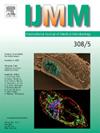Improved ability to utilize lactose and grow in milk as a potential explanation for emergence of the novel bovine Staphylococcus aureus ST5477
IF 3.6
3区 医学
Q1 MICROBIOLOGY
引用次数: 0
Abstract
Staphyloccous aureus belonging to sequence type 5477 have recently been identified as a predominant clone causing bovine mastitis in Rwanda and Tanzania. We compared nine S. aureus ST5477 to 17 isolates belonging to other sequence types by their biochemical profile and ability to acidify milk and grow in minimum media containing lactose. We found that ST5477 isolates all were positive in ONPG (o-nitrophenyl-β-D-galactopyranoside) test and negative for mannitol fermentation potentially challenging the correct identification of this sequence type as S. aureus. In addition, ST5477 isolates were all much faster in acidifying milk and grew faster in minimal media with lactose compared to other strains suggesting an increased lactose utilization and thereby adaptation to the bovine udder environment as a possible reason for the recent successful emergence. Comparison of the lac gene region of the genome of a recently sequenced ST5477 and that of S. aureus reference genome showed that both strains contained the known lacABCD genes involved in the lactose degradation, but that ST5477 had a 12 amino-acid deletion and two amino-acid differences in the lac gene transcription regulator, suggesting that increased transcription might play a role. In conclusion, these preliminary data suggests that improved lactose utilization and the ability to grow faster in milk may have been a key feature for the recent success of ST5477 as a bovine adapted clone.
提高利用乳糖和在牛奶中生长的能力是新型牛金黄色葡萄球菌 ST5477 出现的潜在原因。
最近在卢旺达和坦桑尼亚发现,属于序列类型 5477 的金黄色葡萄球菌是引起牛乳腺炎的主要克隆。我们比较了 9 株 ST5477 型金黄色葡萄球菌和 17 株属于其他序列类型的分离株的生化特征以及酸化牛奶和在含乳糖的最低培养基中生长的能力。我们发现,ST5477 分离物在 ONPG(邻硝基苯基-β-D-吡喃半乳糖苷)测试中均呈阳性,而在甘露醇发酵中呈阴性,这可能对正确鉴定该序列类型为金黄色葡萄球菌提出了挑战。此外,与其他菌株相比,ST5477 分离物在酸化牛奶中的生长速度更快,在含乳糖的最小培养基中的生长速度也更快,这表明该菌株对乳糖的利用率增加,从而适应了牛乳房环境,这可能是该菌株最近成功出现的一个原因。对最近测序的 ST5477 基因组中的 lac 基因区和金黄色葡萄球菌参考基因组进行比较后发现,两株菌株都含有参与乳糖降解的已知 lacABCD 基因,但 ST5477 的 lac 基因转录调节因子有 12 个氨基酸缺失和两个氨基酸差异,这表明转录增加可能起到了一定作用。总之,这些初步数据表明,乳糖利用率的提高和在牛奶中更快生长的能力可能是 ST5477 作为牛适应性克隆最近取得成功的一个关键特征。
本文章由计算机程序翻译,如有差异,请以英文原文为准。
求助全文
约1分钟内获得全文
求助全文
来源期刊
CiteScore
9.70
自引率
0.00%
发文量
18
审稿时长
45 days
期刊介绍:
Pathogen genome sequencing projects have provided a wealth of data that need to be set in context to pathogenicity and the outcome of infections. In addition, the interplay between a pathogen and its host cell has become increasingly important to understand and interfere with diseases caused by microbial pathogens. IJMM meets these needs by focussing on genome and proteome analyses, studies dealing with the molecular mechanisms of pathogenicity and the evolution of pathogenic agents, the interactions between pathogens and host cells ("cellular microbiology"), and molecular epidemiology. To help the reader keeping up with the rapidly evolving new findings in the field of medical microbiology, IJMM publishes original articles, case studies and topical, state-of-the-art mini-reviews in a well balanced fashion. All articles are strictly peer-reviewed. Important topics are reinforced by 2 special issues per year dedicated to a particular theme. Finally, at irregular intervals, current opinions on recent or future developments in medical microbiology are presented in an editorial section.

 求助内容:
求助内容: 应助结果提醒方式:
应助结果提醒方式:


